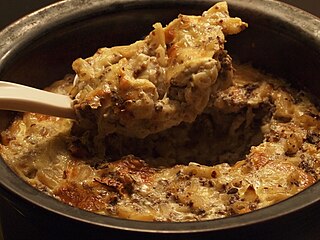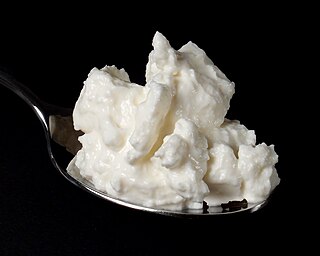| Type | Dessert |
|---|---|
| Place of origin | Finland |
| Main ingredients | Colostrum, salt; or milk and eggs |
Uunijuusto is a Finnish dish made from cow's colostrum, the first milk of a calved cow, [1] salted and baked. Sometimes uunijuusto is also made from ordinary milk and eggs. In Sweden, the dish is named kalvdans (calve's dance).
The word uunijuusto literally means "oven cheese", but uunijuusto is not properly a cheese. [2]
Uunijuusto is sometimes eaten for dessert with berries (often cloudberries) or jam or mehukeitto, a soup made from fresh berries such as lingonberries or redcurrants.

Swedish cuisine is the traditional food of Sweden. Due to Sweden's large north-to-south expanse, there are regional differences between the cuisine of North and South Sweden.

A pancake is a flat cake, often thin and round, prepared from a starch-based batter that may contain eggs, milk and butter and cooked on a hot surface such as a griddle or frying pan, often frying with oil or butter. It is a type of batter bread. Archaeological evidence suggests that pancakes were probably eaten in prehistoric societies.

Curd is obtained by coagulating milk in a sequential process called curdling. It can be a final dairy product or the first stage in cheesemaking. The coagulation can be caused by adding rennet, a culture, or any edible acidic substance such as lemon juice or vinegar, and then allowing it to coagulate. The increased acidity causes the milk proteins (casein) to tangle into solid masses, or curds. Milk that has been left to sour will also naturally produce curds, and sour milk cheeses are produced this way.

Finnish cuisine is notable for generally combining traditional country fare and haute cuisine with contemporary continental-style cooking. Fish and meat play a prominent role in traditional Finnish dishes in some parts of the country, while the dishes elsewhere have traditionally included various vegetables and mushrooms. Evacuees from Karelia contributed to foods in other parts of Finland in the aftermath of the Continuation War.

Pierogi are filled dumplings, made by wrapping unleavened dough around a filling, and occasionally flavored with a savory or sweet garnish and cooking in boiling water.

Semolina is the name given to coarsely milled durum wheat mainly used in making couscous, pasta, and sweet puddings. The term semolina is also used to designate coarse millings of other varieties of wheat, and sometimes other grains as well.

A soufflé is a baked egg dish originating in France in the early 18th century. Combined with various other ingredients, it can be served as a savoury main dish or sweetened as a dessert. The word soufflé is the past participle of the French verb souffler, which means to blow, breathe, inflate or puff.

Bread cheese, known in the United States as Finnish squeaky cheese, is a Finnish fresh cheese traditionally made from cow's colostrum, in America cow's milk is used or even goat milk can also be used. Commercially available versions are typically made from cow's milk. The cheese originally comes from Southern Ostrobothnia, Northern Finland, and Kainuu.

Kissel or kisel is a simple dish with the consistency of a thick gel. It belongs to the group of cold-solidified desserts, although it can be served warm.

Ostkaka, ost meaning "cheese" and kaka meaning "cake" in Swedish, also known as Swedish cheesecake or Swedish curd cake, is a Swedish dessert that has its roots in two different parts of Sweden, Hälsingland and Småland, though there are some differences between ostkaka from Hälsingland resembling halloumi in texture, and the soft-grained ostkaka from Småland.
Quesillo refers to different Latin American, Spanish, and Filipino foods or dishes depending on the country:

Cheese on toast is made by placing sliced or grated cheese on toasted bread and melting it under a grill. It is popular in the United Kingdom, Ireland, Australia, New Zealand, the Caribbean, and in African countries.

Macaroni casserole is a dish of baked pasta. It is especially known as a staple in northern European home cooking. It is a dish of cooked macaroni and a mixture of egg and milk with additional ingredients like meats, vegetables or fish. It is commonly made with cheese or breadcrumbs sprinkled on top.

Vispipuuro, russedessert (Norwegian), vispgröt/klappgröt/klappkräm or mannavaht is a sweet, wheat semolina (manna) cold porridge made with berries, usually lingonberries.

Kalvdans is a classical Scandinavian dessert. It is made from unpasteurized colostrum milk, the first milk produced by a cow after giving birth.

Quark or quarg is a type of fresh dairy product made from milk. The milk is soured, usually by adding lactic acid bacteria cultures, and strained once the desired curdling is achieved. It can be classified as fresh acid-set cheese. Traditional quark can be made without rennet, but in modern dairies small quantities of rennet are typically added. It is soft, white and unaged, and usually has no salt added.